Stop Making These 10 Smoothie Mistakes That Cause Weight Gain

You've swapped out your breakfast for what you thought was a healthy smoothie, but the scale hasn't budged. Sound familiar? According to Autumn Bates, a certified clinical nutritionist with a master's in nutrition and human performance, you might be making some common smoothie slip-ups that could be sabotaging your weight loss goals. "Smoothies can be an amazing way to help you achieve your weight loss or wellness goal, but there are so many ways to get them wrong," Bates warns. Let's dive into her expert advice and learn how to turn your smoothie into a weight-loss powerhouse.
Benefits of Smoothies
Smoothies, when done right, are a powerful way to boost your nutrient intake. They can help you pack in multiple servings of fruits and vegetables in one go, aiding in everything from digestion to energy levels. But, they're more than just a convenient snack. Smoothies provide key vitamins and minerals, and can be a great source of antioxidants, fiber, and hydration. Done properly, they help stabilize blood sugar, support gut health, and even assist in weight management by keeping you full and satisfied throughout the day. When you avoid common pitfalls, smoothies become more than just a tasty treat—they become a health-boosting elixir!
Fruity Foundation Folly
"You're using fruit juice as the base of your smoothie," Bates points out. This common mistake can turn your health drink into a sugar bomb. "Using about 10 ounces of this will add just the base of about 26 grams of sugar. That's literally more than a Reese's peanut butter cup," she explains. To keep your blood sugar stable, Bates recommends, "Instead of using fruit juice as a base, opt for unsweetened nut milk like coconut milk or almond milk."
Protein Powder Overload
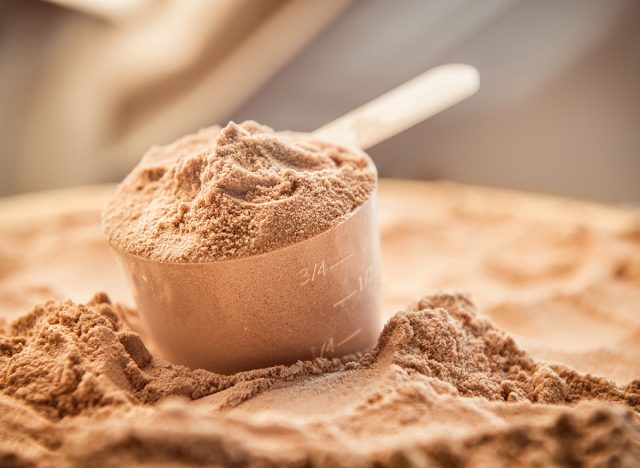
You might think loading up on protein is the key to muscle gain and weight loss, but Bates disagrees. "What I often see is people do a scoop of plant-based protein, a scoop of collagen, a scoop of BCAAs, and just layer these on," she observes. This protein overload can backfire. Bates explains, "When we reach that max on how much protein that we really need in a day, our body actually starts to convert that protein into carbohydrates through a process called gluconeogenesis."
RELATED: I Lost 110 Pounds: Here Are the 19 Most Unhealthy Junk Foods I'll Never Touch Again
Raw Kale Conundrum
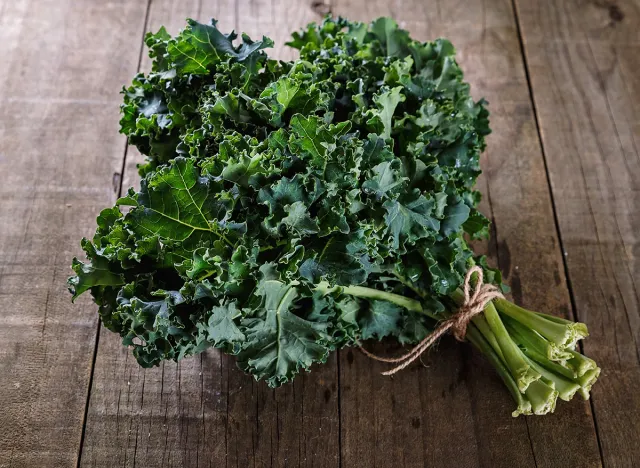
While kale is often touted as a superfood, Bates cautions against using it raw in smoothies. "Having raw kale is not necessarily a good idea, very hard to break down, which can cause extra stress on the GI tract," she warns. For those who still want to include this nutrient-dense green, Bates suggests, "You could always steam it and then freeze it and just add it into your smoothies that way."
Fearing the Fat
"We always talk about on the channel how in order to maintain satiety, which is very important for weight loss goals, we need protein, fat, and fiber," Bates emphasizes. Don't shy away from including healthy fats in your smoothie. As Bates explains, "Fat does not cause that insulin response the way that carbohydrates do and remember insulin is the storing hormone."
Fruit Frenzy
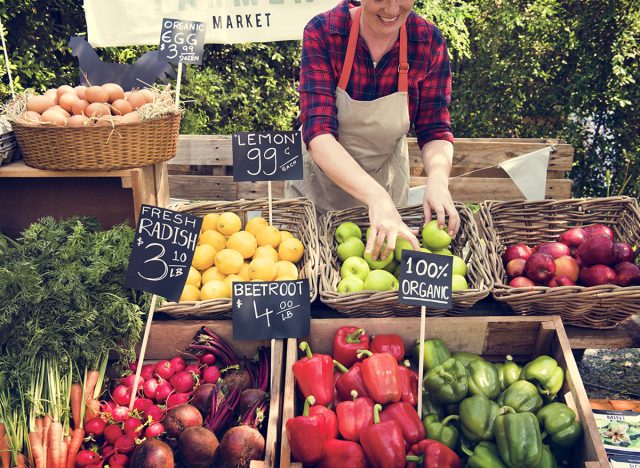
While fruit isn't inherently bad, Bates warns against overdoing it. "Just because it's not bad doesn't mean that way too much of it is not going to cause problems," she states. Bates advises moderation: "You don't want to be using multiple cups worth of fruit or multiple bananas in your smoothie because the sugar content can really start to build on it."
Monotonous Mixing
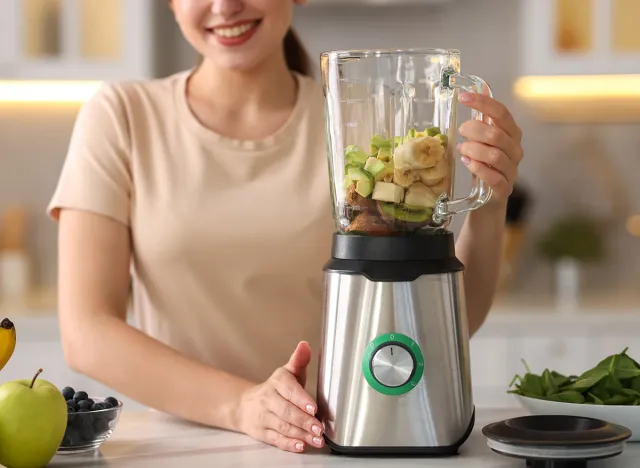
Sticking to the same smoothie recipe daily might be convenient, but it limits your nutrient intake. Bates recommends, "Alternating your fats, alternating the fiber sources, even alternating your protein sources can help to make sure that you're getting the nutrients that your body actually needs."
RELATED: 7 Proven Habits of People Who Lose Weight and Keep It Off
Spice-Free Sipping
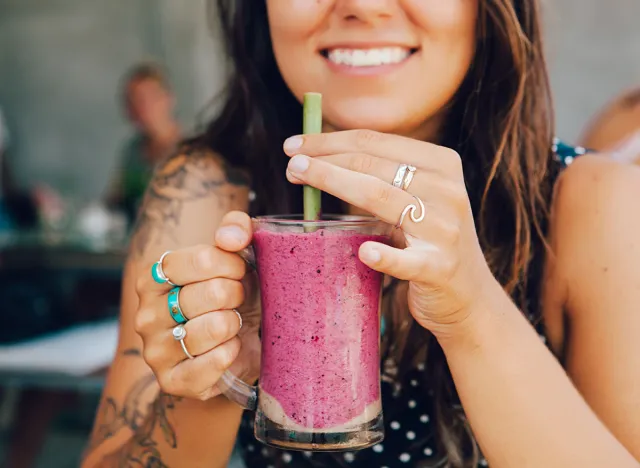
Pay attention to the power of spices in your smoothies. "There's actually been studies that have found that cinnamon is really helpful for balancing blood glucose levels," Bates shares. She also suggests incorporating anti-inflammatory spices like ginger and turmeric.
Nutty Additives
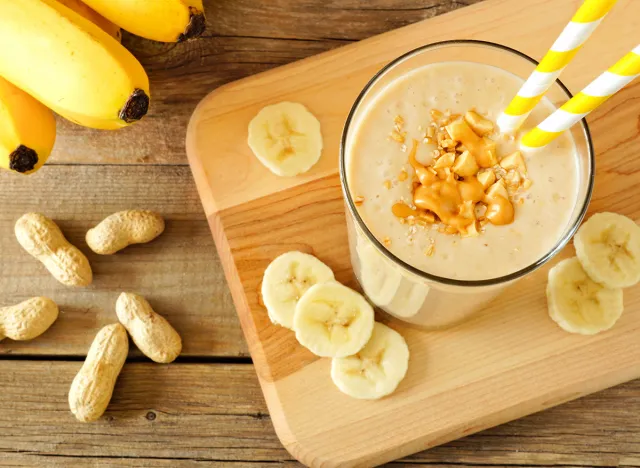
When it comes to nut butters, Bates advises caution. "Make sure that the nut kinds of butter that you're using for your fat source are actually free of any added ingredients," she warns. Avoid options with added sugars or oils, which can increase inflammation in the body.
Milky Misconceptions

Be wary of "original" plant-based milks. As Bates points out, "You would think that original would be the unsweetened form, but it's not. You have to specifically seek out unsweetened." These can add unnecessary sugars to your smoothie.
Calorie Counting Caution
Finally, Bates warns against focusing too much on keeping smoothies low-calorie. "If you try to keep it low calorie, then that means that you're not going to be shutting off your hunger hormones, which means you're not going to be satiated," she explains. Instead, focus on including satiating ingredients to keep you full and satisfied.
RELATED: 5 Reasons Walking Might Beat Running After 50 (and 3 Reasons It Might Not)
The Final Word from the Nutritionist
By avoiding these common pitfalls, you can transform your smoothie from a potential diet derailment into a powerful tool for achieving your wellness goals. As Bates reminds us, it's not about deprivation but about making informed choices that nourish your body and support your health journey. And if you enjoyed this article, take advantage of these 15 Quick Ways to Lose Body Fat Percentage in a Week.




